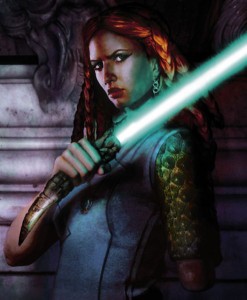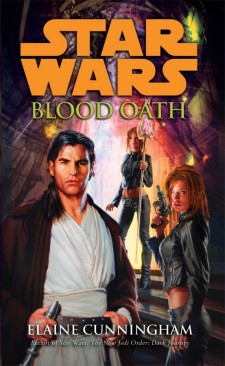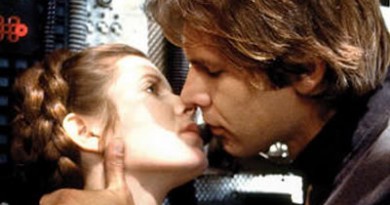Blood, Honor and Matriarchs: The Hapan Women of Star Wars – Part Four
With a discussion on Hapan agent Taryn Zel and Queen Mother Tenel Ka, Kay, B.J., and I bring to a close the four-part series on the Hapan women of Star Wars. The characters of Hapes are not the only ones who inspire us, but they do bring plenty of opportunities to enrich the galaxy far far away. While Blood Oath is likely a mythic relic of a the pre-Disney era, in concept it offered something many fans were hoping to see from the Expanded Universe – stories about lesser known characters without the galaxy-ending peril. And let’s not forget the romance, because, you know, it sells. Recent offerings like Kenobi and the Empire and Rebellion books have tinges of romance, but not in the way the conceit needs to work to appeal to the book-reading masses.
Remarkably, the timing of the last two posts aligned with the diversity discussion surrounding the Star Wars Rebels character reveals. This is not a new topic in Star Wars fandom, but it is apparent fans are realizing that they must raise their voices to be counted, much as actress Olivia Wilde noted in her panel discussion we reported on this weekend. You can find the previous three posts in this series as follows, Part One, Part Two, Part Three, and all FANgirl’s posts on diversity here.
Introduced in the Legacy of the Forces series, Taryn Zel is a Hapan covert agent loyal to its Queen Mother, Tenel Ka. She is depicted with a sexist attitude toward men. Should sexist attitudes be portrayed in Star Wars?
Kay: There’s still so much about Taryn we don’t know, but I wonder if she’s understanding about not everyone in the galaxy believing women are superior as she does or if she looks down on those who differ or however she handles it. A character with a sexist attitude in a fictional story could be used to show how that attitude can be detrimental to working with others, how it makes others feel, and provide a growth point for a character.  It really depends on how that attitude is handled.
It really depends on how that attitude is handled.
B.J.: The risk of portraying a sexist character in fiction is that they becoming a caricature – the sort of moustache-twirling villain who’s so obviously evil that his or her evilness is practically comedic. The Nazis in the Indiana Jones movies work because the entire series is comedic and campy, and no one needs to reminded that ethnic cleansing is abominable. To impact the readers or viewers in a meaningful way, the portrayal of sexism or other discrimination has to make them think – rather than roll their eyes or laugh at the absurdity of the villain. So an inversion of real-world dynamics can help to do this. Most real-world audiences haven’t seen a woman (much less a group of women) being sexist toward men. Watching it happen could definitely open some eyes.
Tricia: Characters are always dependent on the author fleshing out the motivations before putting them down on the page. Sexism is one form of a superiority complex, like racism, speciesism, and ageism. Taryn’s sexism comes from the culture she was raised within. The men of the Hapan Consortium were killed off, and women were left as the power majority in their society. When the portrayals are done well, a man reading Taryn’s character should feel uncomfortable with her attitude toward men, and perhaps the result might be that he reflects on whether those attitudes ever are present in his own behavior. Though not on the page much, Zekk’s relationship with Taryn showed signs that she was rethinking her beliefs about men and women. For instance, in Apocalypse we see Zekk earning Taryn’s respect.
When we first started this series, one of the goals was to emphasize our disappointment in the cancellation of Blood Oath. Why did you think that book would have been a good addition to the Star Wars Expanded Universe? With the state of the Expanded Universe up in the air, would you still read a tightly focused character driven book like this, even if it were to end up as an Alternate Universe?
Kay: I imagine it would have given us a more fleshed out look at Hapan society including but also beyond the monarchy. It held potential for a non-Tenel Ka Hapan perspective about their own region as well as the rest of the galaxy. Clearly something was up out there that Zekk got involved in and it either kept him from or made him decide not to reconnect with the Jedi. What was it? Someone please tell me. I’ve wondered what happened between the end of the civil war in Legacy of the Force and where the beginning of Fate of the Jedi lands us. What was the fallout in the Hapan Consortium? How did the Empire start to deal with the sudden leadership of Jagged Fel, an outsider raised in an alien culture?  This has definitely been one of the books whose cancellation I’m still a bit sad about. I would read this book whenever it came out regardless of whether someone called it Expanded Universe or Alternate Universe or Super Special Fun, Yet Complicated Times Universe.
This has definitely been one of the books whose cancellation I’m still a bit sad about. I would read this book whenever it came out regardless of whether someone called it Expanded Universe or Alternate Universe or Super Special Fun, Yet Complicated Times Universe.
B.J.: Regardless of what comes next, Legacy of the Force and Fate of the Jedi will still exist as stories. Because Blood Oath was a bridge novel of sorts between the two series, it would still work as a story. So why not? The Hapans are a lot of fun, secret societies always present great intrigue, and Zekk as the lone Jedi in the story could certain carry his weight as an action hero. As I recall, the original description of Blood Oath also included an angle with Jag and the Imperials becoming involved. I’m not sure if that would still work given the developments that occurred in FotJ – but if Blood Oath were going to be written now, it wouldn’t have to use all of the original story’s elements. An author skilled at political intrigue, subterfuge, and covert ops styles of stories could really thrive with a Hapan-centered storyline.
Tricia: For one, I think Blood Oath has the potential to be a tight story with some stakes. We don’t know much about the Hapan Consortium and the fall-out of their role in the war. Prince Isolder is dead and Tenel Ka is a Jedi Queen in a treacherous society that doesn’t like Jedi. Fate of the Jedi hinted at the secret society of which the Taryn and her twin Trista were members. Given the popularity of stories woven around secret societies like the Freemasons or Knights Templar, this type of story would be intriguing. Additionally, while sword and sorcery and horror conceits have worked their way into Star Wars books, the romance conceit, which the cover certainly hinted at, has been given the long arm.
In The Clone Wars, the Mandalorian characters in the story ranged from pacifists like Duchess Satine to her Death Watch warrior sister Bo-Katan. On a broader level, their culture reflected views that were distinctly different from those of the Jedi, and members of the Senate like Padmé who were working toward a diplomatic solution to the war. Do you think a Hapan character would fit well into the movie universe?
Kay: I don’t see why a Hapan character wouldn’t fit into the movie part of the universe. A Hapan character could easily bring a different perspective to an event. He or she could be a part of beings working toward a common goal even though perspectives may differ or even provide a challenging situation or obstacle to another character without necessarily being a villain. I keep thinking back to how in Fate of the Jedi, it was said that the Hapans were giving Jag, the Imperial Chief of State, trouble even though the Hapan Queen Mother Tenel Ka respects Jag and Jag wasn’t responsible nor had any relation to the incident that is angering them. I could see a situation like that in a movie.
B.J.: To the extent a character like Taryn Zel is essentially Black Widow in The Avengers – a skilled covert agent in a world where some heroes have high-tech super-suits or superhuman/supernatural powers – then I think she’d fit into Star Wars just fine. An evil machinations mastermind like Ta’a Chume could be fun, too, but we’ve already seen a movie villain like that with Palpatine, so I’d rather see something different.
Tricia: I love how the culture is based on the Hapan’s piracy heritage. They are different in so many ways, Battle Dragons, back-stabbing royals, and power-grabbing women, that it would be a nice way to develop diversity. Tenel Ka is a character that is ripe for the screen. She represents disabled people, persons of mixed dissent as a Hapan-Dathomiri, and she has to straddle being a Jedi and a Queen.
Finally, what other ways do you think Star Wars can enlighten its fans about issues that affect our society today? What lessons can be taught through fictional storytelling?
Kay: Stories always resonate more with us when they contain elements we can relate to or aspire to — bonus points if they include both. So I think it’s important for the Star Wars stories to continue to have those touchpoints. Beyond that Star Wars is a prime environment for illustrating how there are a lot of different “normals” in our world, but it’s possible to co-exist. There will always be those looking to take advantage of others but there will also always be those working to support others.
B.J.: I agree with Kay that one thing our real world needs a lot more of, not just in the U.S. but around the world, is more tolerance of those who are different from ourselves. Ethnic conflicts, even ethnic cleansing, still occurs too frequently; so does religiously motivated discrimination or violence, even war and terrorism. Sexism and racism remain all too real, as does homophobia. Even if Star Wars does not take on these issues directly – religion, for example, isn’t really a part of the Star Wars saga the way it is in the real world – it can certainly tell stories about tolerance, acceptance, and compassion for difference.
Tricia: I think Kay said it best with “there are a lot of different “normals,”” which aligns with my hope: to see a vast array characters that all sorts of people can relate to.
Currently a tenured law professor in Florida, B.J. has been a practicing lawyer in Washington, D.C., a law clerk to a federal appeals court judge, and a law journal editor-in-chief. He is also a proud geek dad whose son who is a big fan of Star Wars and The Clone Wars. You can contact him by email at lex@fangirlblog.com.
Kay grew up wanting to be an astronaut. After seeing Star Wars, she wanted to be Princess Leia, Han Solo, and an astronaut. Life’s taken her on a bit of a different path for now, but she’s still a Star Wars fangirl at heart who enjoys surprising people with how geeky she really is. Currently a photographer who also specializes in communications and marketing, Kay spends her free time reading, cooking, writing, learning and, of course, making pew pew noises. You can follow her on Twitter.
- Hyperspace Theories: Bad Luck Ghorman - June 2, 2025
- Hyperspace Theories: One Year Later as ANDOR Kicks Off Season Two - May 15, 2025
- REVIEW: Tales of the Underworld - May 4, 2025









